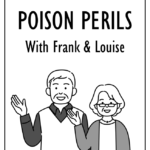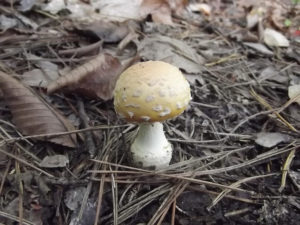Mushrooms
Expand All Collapse All
- What are they?
- Symptoms
- First Aid
- Prevention
What are they?
What are poisonous mushrooms?
Mushrooms are the fruiting bodies of certain types of fungus. There are dozens of types of mushroom that commonly grow wildly in the eastern United States. Some of them are edible, but others can be very harmful if you eat them.
Young children may unknowingly put harmful mushrooms in their mouths while exploring, while older children may eat wild mushrooms thinking they are safe, or in showing off or responding to dares.
Adults sometimes pick harmful mushrooms to eat, thinking they are safe.
Some common harmful “lookalike” mushrooms that we hear about at the Northern New England Poison Center are:
- Jack o’lanterns
- Pigskin poison puffballs
- False morels
- Certain types of boletes, such the lilac brown bolete and boletus sensibilis
- Certain types of amanitas, such as amanita pantherina and amanita muscaria
Symptoms
What are the symptoms of mushroom poisoning?
Most harmful mushrooms are stomach irritants, which means that if you eat one you may:
- Get a stomach ache
- Have diarrhea
- Throw up
These symptoms will usually show up within 30 minutes, but may take longer. In some cases, they can be quite severe.
More dangerous mushrooms may take 6 hours or more to cause symptoms. The symptoms may start with diarrhea or stomach cramps. These mushrooms can make your kidneys or liver stop working. You could need a transplant or even die.
Other types of mushrooms can cause hallucinations or make you feel anxious. People occasionally eat these by mistake, but more often become sick after eating them intentionally to get high.
First Aid
What should I do if a child has eaten a wild mushroom?
- If there are still pieces of the mushroom in the child’s mouth, take them out. Try to keep the mushroom as whole as possible, and do not throw any pieces away.
- Give the child a few sips of water or milk.
- Call the poison center at 1-800-222-1222 or . The poison center will help determine whether the mushroom is harmful and what you need to do next.
- Our poison specialists will ask you to take a few pictures of the mushroom from different angles, alongside a coin or similar object to see the size. It helps to have as much of the mushroom as possible. If you can, dig up the entire mushroom, including the root, keeping the mushroom as whole as you can.
- It also helps us if you can say where the mushroom was growing—in grass or dirt, on a tree or close to trees, etc.
What should I do if I’m having symptoms after eating wild mushrooms?
If you are having symptoms after eating a mushroom that you or someone else foraged, call the poison center right away at 1-800-222-1222, or text POISON to 85511. As above, be ready to tell the poison center where the mushroom was growing. We will ask you to take pictures if you have any mushrooms remaining.
| If someone has passed out or is not breathing, call 911 right away. |
Prevention
How can I prevent mushroom poisonings?
- Get rid mushrooms in your yard. Check your yard regularly, especially after it rains. Mushrooms can pop up quickly.
- Keep an eye on young children playing in the yard or the woods, and teach older children to ask before touching or eating mushrooms, plants or berries found outside.
- Do not pick and eat mushrooms that you find outside unless you have received training on mushroom identification from an expert. The North American Mycological Association has a list of mushroom clubs, including ones in Maine and New Hampshire, that may have information on available trainings.
Further reading from our blog:
Last Updated: Wednesday October 11th 2017






